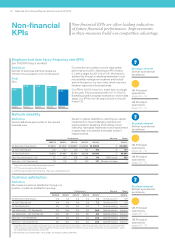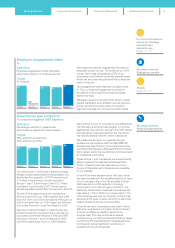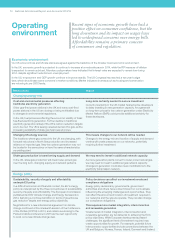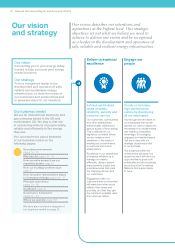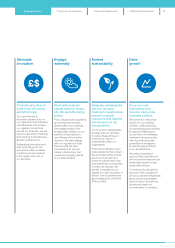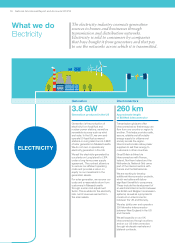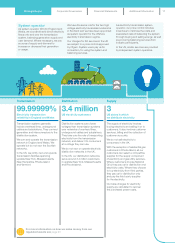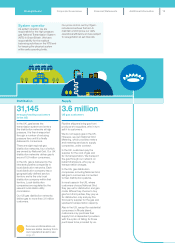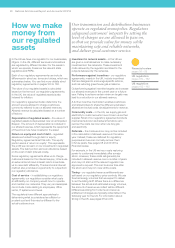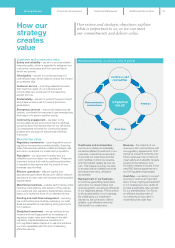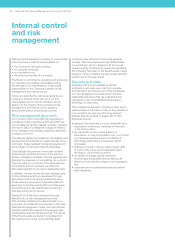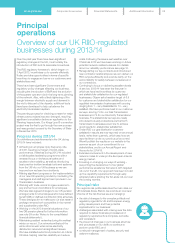National Grid 2014 Annual Report Download - page 22
Download and view the complete annual report
Please find page 22 of the 2014 National Grid annual report below. You can navigate through the pages in the report by either clicking on the pages listed below, or by using the keyword search tool below to find specific information within the annual report.
How we make
money from
our regulated
assets
In the UK we have one regulator for our businesses,
Ofgem. In the US, different services and locations
are regulated by different bodies. For the areas in
which we operate, these are the relevant state
regulators and FERC.
Each of our regulatory agreements can include
differences in structure, terms and values, which we
summarise below. You can find more details about
regulatory agreements on pages 160 to 165.
The value of our regulated assets is calculated
based on the terms of our regulatory agreements.
Inthe UK, the value of regulated assets is also
indexed for inflation.
Our regulatory agreements also determine the
amount we are allowed to charge customers,
commonly referred to as our allowed revenues.
Allowed revenue is calculated based on a number
offactors:
Depreciation of regulated assets – the value of
regulated assets is depreciated over an anticipated
lifespan. The amount of depreciation is included in
our allowed revenue, which represents the repayment
of the amount we have invested in the asset.
Return on equity and cost of debt – regulated
assets are funded through debt or equity.
Regulatory agreements set this ratio. The equity
portion earns a ‘return on equity’. This represents
the profit we can earn on our investment in regulated
assets. The debt portion earns an allowance based
on the cost of debt (interest costs).
Some regulatory agreements allow us to charge
customers based on the interest we pay; others use
an external benchmark interest rate to incentivise
usto raise debt efficiently. The benchmark interest
method also provides an opportunity to outperform
our regulatory allowance.
Cost of service – in establishing our regulatory
agreements, our regulators consider what costs
anefficiently run company would incur to operate
and maintain our networks. They vary and examples
caninclude costs relating to employees, office
rental, IT systems and taxes.
The regulators have different approaches to
determining what is considered an efficient or
prudent cost and this may be different to the
actualcosts we incur.
Investment in network assets – in the UK we
aregiven a cost allowance to make necessary
investments in the networks. These investment
costs allowed by the regulator are linked to the
outputs delivered by the networks.
Performance against incentives – our regulatory
agreements, mainly in the UK, include incentives
that are designed to encourage specific actions,
such as reducing greenhouse gas emissions.
Outperforming against incentive targets can increase
our allowed revenues in the current year or a future
year. Failing to achieve certain minimum targets may
lead to a reduction in our allowed revenue.
A further incentive mechanism enables customers
and shareholders to share the difference between
allowed and actual costs via adjustments to revenue.
Commodity costs – in the US, we supply gas and
electricity to customers who have chosen us as their
supplier. Most of our regulatory agreements include
mechanisms known as trackers that allow us to
recover the costs we incur when we buy gas
andelectricity.
Deferrals – the costs we incur may not be included
in the calculation of allowed revenue in the same
year. Instead, these are deferred for regulatory
purposes and we can normally recover them
infuture years. See pages 08 and 09 of the
Financialreview.
For example, in the US we incur costs restoring
power to customers immediately after a major
storm. However, these costs will generally be
included in allowed revenue over a number of years
and may not start until the relevant regulator has
approved a request. This can be some time after
thestorm and may not cover all the costs.
Timing – our regulated revenue entitlements are
setbased on our regulatory price controls. We use
forecast energy volumes that we expect to deliver
toset the billing tariff. Where there is a difference
between the actual and estimated energy volumes,
the amount of revenue we collect will be different.
Differences arising from volume and revenue
entitlement changes are typically collectable in the
following year for the US. For information about
timing in the UK, see pages 08 and 09.
Financial review
pages 06 – 09
UK regulation
pages 160 – 162
US regulation
pages 162 – 165
Our transmission and distribution businesses
operate as regulated monopolies. Regulators
safeguard customers’ interests by setting the
level of charges we are allowed to pass on,
sothat we provide value for money while
maintaining safe and reliable networks,
anddeliver good customer service.
20 National Grid Annual Report and Accounts 2013/14


